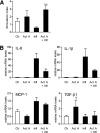Activin A levels are associated with abnormal glucose regulation in patients with myocardial infarction: potential counteracting effects of activin A on inflammation
- PMID: 21464440
- PMCID: PMC3292329
- DOI: 10.2337/db10-1493
Activin A levels are associated with abnormal glucose regulation in patients with myocardial infarction: potential counteracting effects of activin A on inflammation
Abstract
Objective: On the basis of the role of activin A in inflammation, atherogenesis, and glucose homeostasis, we investigated whether activin A could be related to glucometabolic abnormalities in patients with acute myocardial infarction (MI).
Research design and methods: Activin A measurement and oral glucose tolerance tests (OGTTs) were performed in patients (n = 115) with acute MI, without previously known diabetes, and repeated after 3 months. Release of activin A and potential anti-inflammatory effects of activin A were measured in human endothelial cells. Activin A effects on insulin secretion and inflammation were tested in human pancreatic islet cells.
Results: 1) In patients with acute MI, serum levels of activin A were significantly higher in those with abnormal glucose regulation (AGR) compared with those with normal glucose regulation. Activin A levels were associated with the presence of AGR 3 months later (adjusted odds ratio 5.1 [95% CI 1.73-15.17], P = 0.003). 2) In endothelial cells, glucose enhanced the release of activin A, whereas activin A attenuated the release of interleukin (IL)-8 and enhanced the mRNA levels of the antioxidant metallothionein. 3) In islet cells, activin A attenuated the suppressive effect of inflammatory cytokines on insulin release, counteracted the ability of these inflammatory cytokines to induce mRNA expression of IL-8, and induced the expression of transforming growth factor-β.
Conclusions: We found a significant association between activin A and newly detected AGR in patients with acute MI. Our in vitro findings suggest that this association represents a counteracting mechanism to protect against inflammation, hyperglycemia, and oxidative stress.
Figures





References
-
- Haffner SM, Lehto S, Rönnemaa T, Pyörälä K, Laakso M. Mortality from coronary heart disease in subjects with type 2 diabetes and in nondiabetic subjects with and without prior myocardial infarction. N Engl J Med 1998;339:229–234 - PubMed
-
- Kannel WB, McGee DL. Diabetes and cardiovascular disease. The Framingham study. JAMA 1979;241:2035–2038 - PubMed
-
- Rydén L, Standl E, Bartnik M, et al. ; Task Force on Diabetes and Cardiovascular Diseases of the European Society of Cardiology (ESC); European Association for the Study of Diabetes (EASD) Guidelines on diabetes, pre-diabetes, and cardiovascular diseases: executive summary. Eur Heart J 2007;28:88–136 - PubMed
-
- Bartnik M, Rydén L, Ferrari R, et al. ; Euro Heart Survey Investigators The prevalence of abnormal glucose regulation in patients with coronary artery disease across Europe. The Euro Heart Survey on diabetes and the heart. Eur Heart J 2004;25:1880–1890 - PubMed
Publication types
MeSH terms
Substances
LinkOut - more resources
Full Text Sources
Medical

